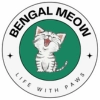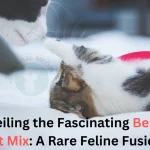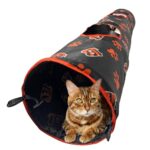Bengal Cat Breed Characteristics: Fascinating Traits Unveiled
The Bengal cat is known for its wild appearance and playful, energetic nature. It has a distinctive spotted or marbled coat.
Bengal cats are a captivating breed, blending the elegance of domestic cats with the exotic look of wild felines. They have a sleek, muscular build and striking coat patterns that resemble those of a leopard. Their eyes are large and expressive, adding to their allure.
Bengals are highly active and intelligent, requiring plenty of stimulation and interactive play. They are also known for their affectionate and social temperament, making them great companions. These cats are vocal and love to communicate with their owners, ensuring they become an integral part of any household.
Origins And History
The Bengal cat breed is known for its wild appearance and domestic temperament. These cats have a fascinating history that dates back to the 1960s. Their unique traits make them a favorite among cat lovers.
Ancestry
The Bengal cat’s ancestry is a blend of wild and domestic cats. The breed originated from crossing an Asian Leopard Cat (ALC) with a domestic cat. This hybridization aimed to create a cat with a wild look but a gentle nature.
The Asian Leopard Cat is a small wild cat found in Asia. It has a distinctive spotted coat similar to a leopard. In contrast, the domestic cats used in breeding were chosen for their friendly and sociable traits.
Development
The development of the Bengal cat breed began in earnest in the 1970s. A breeder named Jean Mill is credited with creating the first Bengal cat. She bred an Asian Leopard Cat with a domestic cat to produce the first generation of hybrids.
These early hybrids were then bred with each other and with other domestic cats. This process aimed to reinforce the desired traits, such as the wild appearance and friendly demeanor. By the 1980s, the Bengal cat had gained recognition as a distinct breed.
The breed gained further popularity in the 1990s. Today, Bengal cats are known for their striking coats, which can be spotted or marbled. Their playful and active nature also makes them a popular choice for pet owners.
| Aspect | Details |
|---|---|
| Ancestry | Asian Leopard Cat and domestic cat |
| First Breeder | Jean Mill |
| Recognition | 1980s |
| Coat Patterns | Spotted or marbled |
The Bengal cat breed continues to evolve. Breeders focus on maintaining the unique characteristics that make Bengals stand out. Their wild appearance combined with a loving nature makes them a truly special breed.
Physical Appearance
The Bengal cat is a stunning breed known for its wild look. This cat’s appearance is one of its most distinctive features. From its coat patterns to its eye colors, the Bengal cat captivates everyone.
Coat Patterns
The Bengal cat’s coat is its crowning glory. It boasts two primary patterns: spotted and marbled.
| Pattern | Description |
|---|---|
| Spotted | Spots vary in size and shape, resembling a leopard’s coat. |
| Marbled | Swirls and streaks across the body, creating a unique look. |
These patterns make each Bengal unique. Their coats are also short and dense, giving them a sleek look. The fur often has a glittery effect, adding to their allure.
Eye Colors
Bengal cats have striking eyes that enhance their wild appearance. Common eye colors include:
- Green
- Gold
- Blue (often seen in Snow Bengals)
Their eyes are large and almond-shaped, adding to their exotic look. The eye color can vary based on the coat color. For example, Snow Bengals often have blue eyes.
Behavior And Temperament
The Bengal cat breed is known for its striking appearance, but their behavior and temperament are equally fascinating. These cats are energetic, social, and intelligent, making them a unique addition to any household.
Playfulness
Bengal cats are incredibly playful. They have high energy levels and love interactive toys. Owners often find them chasing laser pointers or playing fetch. Their playful nature makes them entertaining pets.
Bengals also enjoy climbing and exploring their surroundings. Cat trees and shelves are great for keeping them engaged. Their agility and curiosity lead to hours of fun and activity.
Social Nature
Bengal cats have a strong social nature. They form close bonds with their owners and enjoy being involved in daily activities. These cats are not typically aloof or distant.
They often follow their humans around the house, seeking attention and companionship. Bengals can also be quite vocal, using various sounds to communicate their needs and emotions.
They usually get along well with other pets, including dogs. Their social temperament makes them well-suited for families and households with multiple animals.
| Characteristic | Description |
|---|---|
| Playfulness | High energy, loves interactive play, enjoys climbing |
| Social Nature | Forms strong bonds, seeks attention, vocal communicator |
Health And Lifespan
Bengal cats are known for their stunning looks and playful nature. Understanding their health and lifespan helps ensure they live long, happy lives. This section covers common health issues and their life expectancy.
Common Health Issues
Like all breeds, Bengal cats can face specific health problems. Here are some common health issues:
- Hypertrophic Cardiomyopathy (HCM): A common heart disease in Bengals.
- Progressive Retinal Atrophy (PRA): This affects their vision over time.
- Feline Infectious Peritonitis (FIP): A viral disease that can be fatal.
- Luxating Patella: A condition where the kneecap dislocates.
Regular vet check-ups are crucial. Early detection can help manage these issues effectively.
Life Expectancy
Bengal cats generally have a long life expectancy. They often live between 12 to 16 years. With proper care, some may even surpass this range.
| Factor | Impact on Lifespan |
|---|---|
| Diet | A balanced diet ensures good health. |
| Exercise | Regular playtime keeps them fit. |
| Vet Visits | Annual check-ups catch health issues early. |
Ensuring a healthy environment adds years to their lives. Love and attention go a long way in their well-being.
Diet And Nutrition
Bengal cats are known for their stunning appearance and playful personality. To keep them healthy, their diet and nutrition must be carefully managed. This section explores the dietary needs and feeding tips for Bengal cats.
Dietary Needs
Bengal cats need a balanced diet. They are obligate carnivores, so protein is essential. Animal-based proteins are the best source. These include chicken, turkey, and fish. Carbohydrates should be limited. Too many carbs can lead to obesity.
Here is a table to summarize the dietary needs:
| Nutrient | Source |
|---|---|
| Protein | Chicken, turkey, fish |
| Fats | Animal fats, fish oil |
| Vitamins | Vitamin A, Vitamin E |
| Minerals | Calcium, phosphorus |
Feeding Tips
Here are some feeding tips for Bengal cats:
- Feed them high-quality cat food.
- Split meals into smaller portions.
- Keep a consistent feeding schedule.
- Always provide fresh water.
- Avoid giving them human food.
Follow these tips to ensure your Bengal cat stays healthy and happy.
Grooming Requirements
The Bengal cat is a unique and stunning breed. Their grooming needs are simple but essential for their health and happiness. Below, we will explore the necessary steps to keep your Bengal cat looking its best. We will cover coat care and nail trimming.
Coat Care
Bengal cats have a sleek, soft coat. Their fur is short and dense. This makes them less prone to matting. To keep their coat shiny and healthy, regular brushing is important. Use a soft bristle brush or grooming glove.
- Brush your Bengal cat once a week.
- This removes loose hair and reduces shedding.
- It also helps distribute natural oils.
- Your cat will enjoy the bonding time.
Brushing also helps you check for any skin issues. Look for redness, bumps, or parasites. If you notice anything unusual, contact your vet.
Nail Trimming
Nail trimming is crucial for your Bengal cat’s comfort. Overgrown nails can cause pain and health issues. Trim your cat’s nails every few weeks. Use a pair of cat nail clippers for the best results.
- Hold your cat gently but firmly.
- Press the paw to extend the nails.
- Trim the sharp tips, avoiding the quick.
- Offer treats to keep your cat calm.
Regular nail trimming prevents scratching damage to furniture. It also keeps your Bengal cat comfortable and happy.
By following these simple grooming steps, you will ensure your Bengal cat stays healthy and beautiful. Regular coat care and nail trimming are key to a happy Bengal cat.
Training And Exercise
Bengal cats are highly active and intelligent. They need proper training and exercise to stay happy and healthy. Understanding their unique needs is crucial for any Bengal cat owner. Let’s dive into the specifics of training and exercise for these energetic felines.
Training Tips
Training a Bengal cat can be a fun and rewarding experience. They are smart and can learn quickly with the right approach.
- Start Early: Begin training when they are kittens. Younger cats adapt faster.
- Use Positive Reinforcement: Reward good behavior with treats or affection.
- Be Consistent: Use the same commands and rewards every time.
- Short Sessions: Keep training sessions short to maintain their interest.
- Patience is Key: Be patient and gentle. Avoid harsh punishments.
Exercise Needs
Bengal cats have high energy levels. They need regular exercise to stay fit and mentally stimulated.
| Activity | Frequency | Duration |
|---|---|---|
| Interactive Play | Daily | 30 minutes |
| Climbing | Daily | 20 minutes |
| Walking on Leash | Weekly | 15 minutes |
Providing a variety of activities keeps them engaged. Consider cat trees, puzzle toys, and interactive games. A bored Bengal cat can become destructive. Ensuring they get enough exercise helps prevent this.
Living Environment
The Bengal cat breed is known for its energetic and playful nature. Understanding their ideal living environment is key to keeping them happy. Whether you choose to keep your Bengal cat indoors or allow them outdoor access, each option has its own considerations.
Indoor Vs. Outdoor
Indoor Bengal cats often enjoy a safer and more controlled environment. They are protected from traffic, predators, and diseases. Indoor cats also have fewer chances of getting lost or stolen. However, they require more stimulation to prevent boredom.
Outdoor Bengal cats benefit from natural sunlight and fresh air. They can explore, climb, and hunt, which keeps them physically active. But outdoor cats face risks like cars, other animals, and harsh weather conditions. It is crucial to weigh these pros and cons carefully.
Ideal Home Setup
Creating the perfect home setup for a Bengal cat involves several elements:
- Space: Bengals need ample space to run and play. Small apartments may not be ideal.
- Toys and Activities: Interactive toys, climbing trees, and scratching posts are essential. These items keep them engaged and active.
- Windows: Bengals love watching the outside world. Large windows or a catio can be great additions.
- Safe Zones: Provide quiet areas where your Bengal can retreat and relax. This helps them feel secure.
| Element | Importance |
|---|---|
| Space | High |
| Toys and Activities | High |
| Windows | Medium |
| Safe Zones | High |
Bengal cats thrive in environments that cater to their curiosity and energy. Ensuring they have the right setup will keep them content and healthy.
Frequently Asked Questions
What Is A Bengal Cat?
A Bengal cat is a hybrid breed, known for its striking leopard-like coat.
Are Bengal Cats Hypoallergenic?
Bengal cats are not hypoallergenic, but they produce fewer allergens than many breeds.
How Big Do Bengal Cats Get?
Male Bengals weigh 10-15 pounds; females are smaller at 8-12 pounds.
Do Bengal Cats Get Along With Kids?
Yes, Bengals are generally friendly and enjoy interacting with children.
Are Bengal Cats High-energy?
Bengals are very active and love to climb, jump, and play.
What Do Bengal Cats Eat?
Bengals thrive on high-protein diets, often including quality wet and dry cat food.
How Long Do Bengal Cats Live?
Bengal cats typically live 12-16 years with proper care and nutrition.
Do Bengal Cats Need Special Care?
Bengal cats need mental stimulation, regular playtime, and a balanced diet to stay healthy.
Are Bengal Cats Vocal?
Bengals are known for their loud, distinctive meows and frequent vocalizations.
Do Bengal Cats Shed A Lot?
Bengal cats have short coats and shed less than many other breeds. Regular grooming helps.
Conclusion
The Bengal cat breed offers unique and captivating characteristics. Their playful nature and striking appearance make them special. Perfect for active households, they thrive on engagement. Understanding their needs ensures a happy, healthy pet. Consider a Bengal cat for a lively and affectionate companion.




